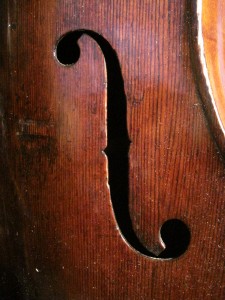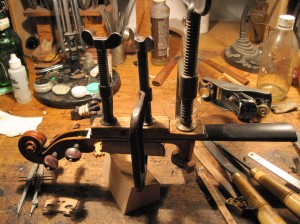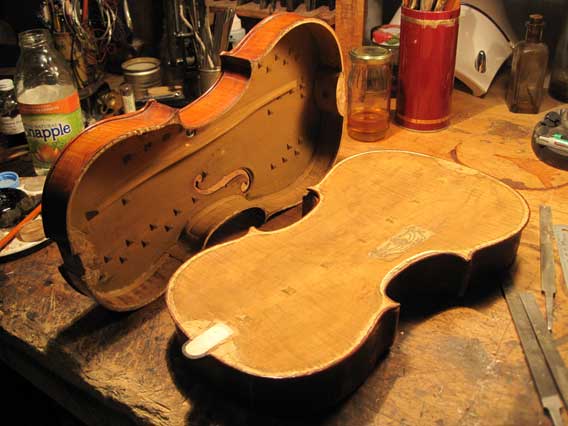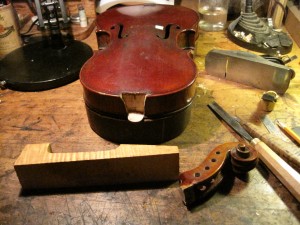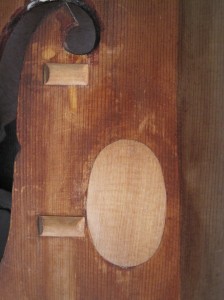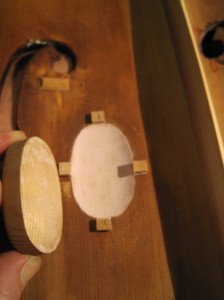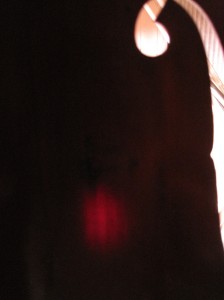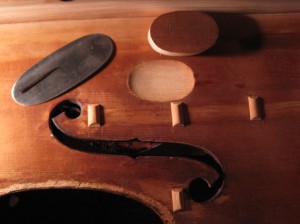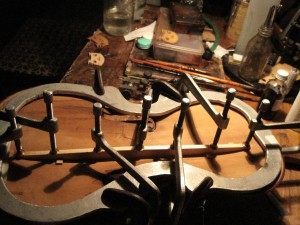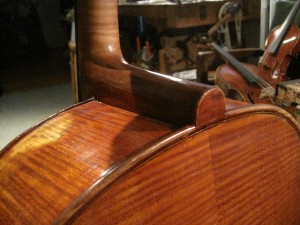
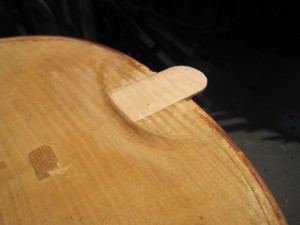 This cello belongs to the great Philadelphia cellist Lorne Munroe. It was made for him by Thomas Elmer in Philadelphia in 1960. Unfortunately it suffered a fall and the neck pulled out at the button and to make things more difficult the piece of the back known as the button – which is glued to the neck- has separated at the purfling and stayed attached to the neck stock. In order to do this repair properly the back must come off and the button must be carefully removed from the neck and reglued to the back. Then the break will be discretely reinforced with new wood spanning the break.The back then is glued back on and the button area is ready for varnish touch up that will make the break invisible – which should make you think twice and look very close when buying an old instrument! Lastly, the neck is reset, the varnish is restored and to the untrained eye nothing has happened.
This cello belongs to the great Philadelphia cellist Lorne Munroe. It was made for him by Thomas Elmer in Philadelphia in 1960. Unfortunately it suffered a fall and the neck pulled out at the button and to make things more difficult the piece of the back known as the button – which is glued to the neck- has separated at the purfling and stayed attached to the neck stock. In order to do this repair properly the back must come off and the button must be carefully removed from the neck and reglued to the back. Then the break will be discretely reinforced with new wood spanning the break.The back then is glued back on and the button area is ready for varnish touch up that will make the break invisible – which should make you think twice and look very close when buying an old instrument! Lastly, the neck is reset, the varnish is restored and to the untrained eye nothing has happened.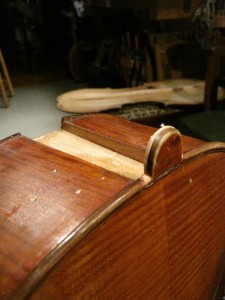
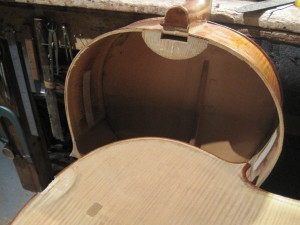
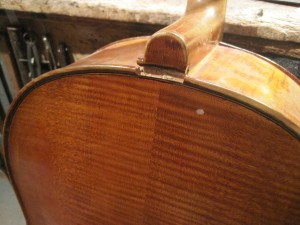
Monthly Archives: April 2011
Bumpy ride on Southwest Airlines
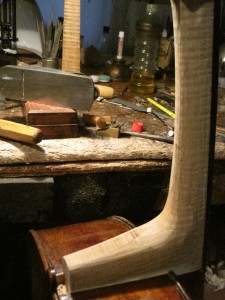
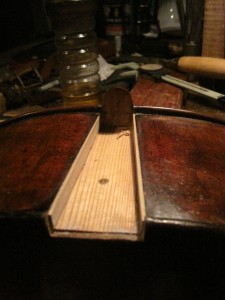
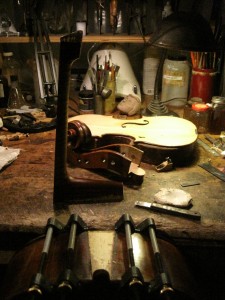 They may be good at moving people inexpensively, but they are certainly not to be trusted with fine musical instruments. This fine, early 19th century German cello was in a very sturdy shipping case when it must have been dealt a stunning blow. Luckily the damage was mostly confined to where the old neck graft joined the scroll. The new graft will carefully clean up all the ragged wood and restore the cello to its previous fine state and value. First the scroll needs to be cleaned up , with the sides of the pegbox flattened and prepared to accept the new neck. Next is the tricky job of getting the old neck out of the body. You carefully(!) make a saw cut just inside the button and work an opening knife along the joint where the neck stock joins the ribs. When you have loosened the neck all around you put clamps on the ribs adjacent to the neck – then the bold part of giving the neck a swift shot to one side. This will release the joint underneath the neck stock – but not without a dramatic (and heart stopping) thwack. This is the glue letting go of the joint between the end grain of the neck (which really is not a very strong joint) and the mortise of the top block. Now its time to prepare the mortise and fashion a new neck.
They may be good at moving people inexpensively, but they are certainly not to be trusted with fine musical instruments. This fine, early 19th century German cello was in a very sturdy shipping case when it must have been dealt a stunning blow. Luckily the damage was mostly confined to where the old neck graft joined the scroll. The new graft will carefully clean up all the ragged wood and restore the cello to its previous fine state and value. First the scroll needs to be cleaned up , with the sides of the pegbox flattened and prepared to accept the new neck. Next is the tricky job of getting the old neck out of the body. You carefully(!) make a saw cut just inside the button and work an opening knife along the joint where the neck stock joins the ribs. When you have loosened the neck all around you put clamps on the ribs adjacent to the neck – then the bold part of giving the neck a swift shot to one side. This will release the joint underneath the neck stock – but not without a dramatic (and heart stopping) thwack. This is the glue letting go of the joint between the end grain of the neck (which really is not a very strong joint) and the mortise of the top block. Now its time to prepare the mortise and fashion a new neck. 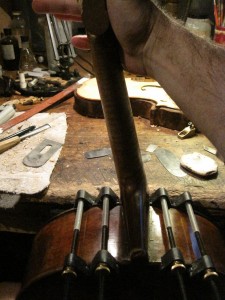
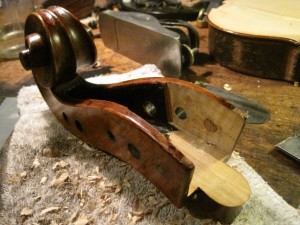
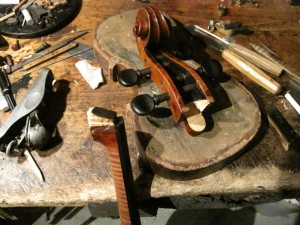
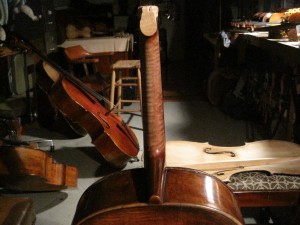
Beautiful 18th century Italian cello
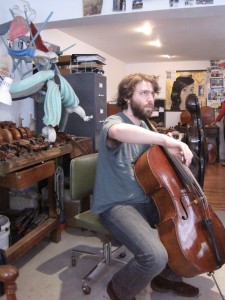
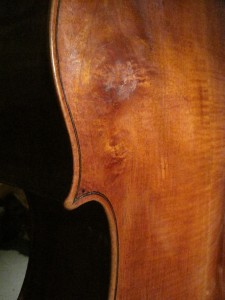
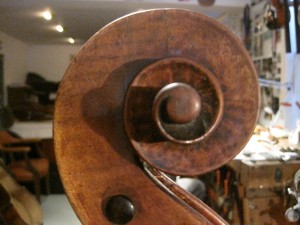
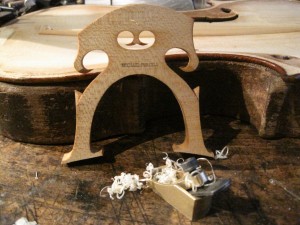 A beautiful cello owned by the famed Guildhall School in London was in my studio recently for some extensive gluing and a new bridge. We decided on a Belgian bridge for its ability to give a cello more punch and bold clarity of sound. With its higher legs and compressed torso the bridge gets to the height it needs to be with less wood than the traditional French bridge blank so there is less material in the way as the bridge transmits the sound from strings to body. The sculptor in me loves cutting these blanks with their graceful leg curves and jaunty, military bearing. The cello itself is a treat to behold with its rugged sculptural power, bold craftsmanship and subtle, artistic details. Bart Lafollette , the promising young cellist who has had the use of this cello treats me to a Bach suite while trying out the “new” cello – He claims it has never sounded better – high praise from him and the fact that the cello has spent time in the finest shops in London. Bart will be recording with the Doric Quartet in London and playing solo gigs in England and on the continent. Its great to be able to help him fill the hall with his great musicality.
A beautiful cello owned by the famed Guildhall School in London was in my studio recently for some extensive gluing and a new bridge. We decided on a Belgian bridge for its ability to give a cello more punch and bold clarity of sound. With its higher legs and compressed torso the bridge gets to the height it needs to be with less wood than the traditional French bridge blank so there is less material in the way as the bridge transmits the sound from strings to body. The sculptor in me loves cutting these blanks with their graceful leg curves and jaunty, military bearing. The cello itself is a treat to behold with its rugged sculptural power, bold craftsmanship and subtle, artistic details. Bart Lafollette , the promising young cellist who has had the use of this cello treats me to a Bach suite while trying out the “new” cello – He claims it has never sounded better – high praise from him and the fact that the cello has spent time in the finest shops in London. Bart will be recording with the Doric Quartet in London and playing solo gigs in England and on the continent. Its great to be able to help him fill the hall with his great musicality.
A nice 1780 Chappuy violin suffers a dramatic injury
[nggallery id=5]
The neck has come violently out of the body of this nice, old French violin due to a fall. The back will have to come off ,the button re-glued and then patched. Then the neck will be reset. It will no doubt re-emerge as a fine violin. Hopefully there will be no trace of the damage- except maybe to the trained eye.
The back has now been taken off and the broken button re-glued to the back(it was still attached to the neck stock from the neck coming out suddenly). Then a patch is fit spanning the break to strengthen the area to hold the tension on the neck set. This patch will be hidden by the ebony ring on the neck stock.
Didier Nicolas violin c. 1825 needs a neck graft
This fine French instrument still has its original neck, but sadly it doesn’t conform to the measurements of todays standards. Its neck length is too short and its height out over the top of the violin is much too low. There is little else one can do but graft the scroll onto a new new block. Done carefully it is barely noticeable. The first step is to remove the neck from the corpus of the violin. You CAREFULLY saw just to the neck side of the button. I will update this process as the work progresses
Nice German cello needs a soundpost patch
This cello had an ill fitting soundpost that was not in the right location.Therefore it didn’t support the top against the tremendous strain of the string tension down on the treble foot of the bridge and eventually the soft spruce top developed a crack. In order to repair this crack you need to first glue the crack and then fit an inlaid patch into the top forming a “landing pad” of new wood for the new soundpost. Without this new patch the immense pressure down on the post post would simply force the crack open again. The first step is to carve out the spruce at the post area. At its deepest point the top is left 1 mm thick. The photo shows light from behind the cello streaming through the patch area. In order for the patch to the completely fit the scooped out shape of the top you need to use chalk as a transfer material. The surfaces must fit exactly so that no distortion of the top will be visible on the outside of the cello. If the patch doesn’t fit well the top will show the imprint of the patch. The chalk must thoroughly cover the patch before it is glued in. Once glued in, it is trimmed and carefully scraped to blend with the contour of the top. Notice that the dark, winter grains of the patch are at a slight diagonal to the grains of the top. This provides added strength by spanning the crack, rather than the grains of the patch running similarly with the top, with the chance that the patch could both soft summer grains over the crack with the soundpost exerting its pressure there and re-opening the crack
Neck Graft on J. B. Vuilluame cello
This fine cello sustained a fall where the neck sheared off.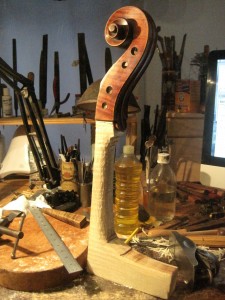 At this point in the process the old neck has been cut away ,the pegbox has been beveled to a flat thin edge and a new neck has been roughed out and glued into the pegbox.
At this point in the process the old neck has been cut away ,the pegbox has been beveled to a flat thin edge and a new neck has been roughed out and glued into the pegbox.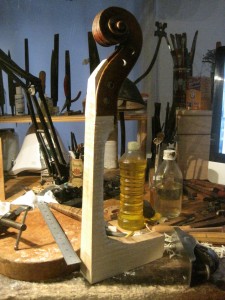 At this point I’ll begin to set the neck – and get it ready to play a piece by Dutilleux by a player in the Philadelphia Orchestra. One of the movements is just the cello section so it better be there!
At this point I’ll begin to set the neck – and get it ready to play a piece by Dutilleux by a player in the Philadelphia Orchestra. One of the movements is just the cello section so it better be there!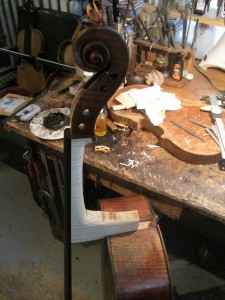
Late night bass bar
A beautiful,small English viola c. 1800 by William Forster. The bass bar is crucial to the lower registers resonance. It has two functions. It helps support the top against downward string tension exerted through the bridge .It also acts as a conduit through which the vibrations are spread out over the whole spruce top. The soft spruce of the top flexes widely giving the lower register its “growl”. This viola is a higher arched model which means the bar can and should be slighter since the higher arching needs less support. Few bars are correct in terms of placement and heft. I make sure all my instruments have a proper bass bar.
